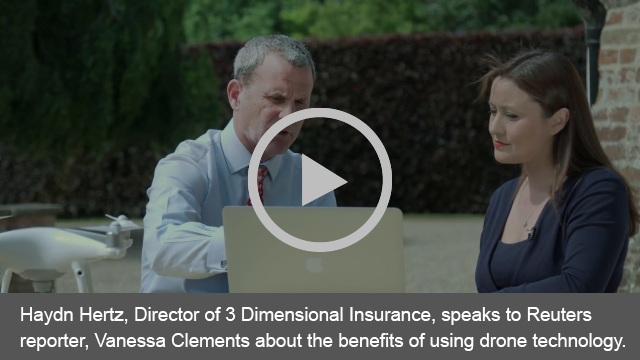Are commercial property owners getting enough from their insurance?
The insurance industry has remained relatively resilient to digital transformation. Its age-old business model, regulation and product complexity has meant little has changed over the decades. But now, the Internet of Things is starting to make an impact. In some areas, this is already happening: £218 million has been invested in UK insuretech in the first half of 2017, up from £7.3 million the year before.(1) ('Insuretech' is the term given to the use of emerging technologies by insurance companies).
However, some in the industry believe so much more could still be done to take advantage of new technology and develop the sector. Haydn Hertz, the co-owner of 3 Dimensional Insurance (3Di), a Lloyd’s broker, says money is being ploughed into the industry cashing in on the, as yet, mostly untapped potential. But, he says, the use of new methods to present risk has been stagnant for years. As a result, customers are losing out and it is time for things to change.
Mr Hertz said: “It is regrettable, in my view, that many brokers, especially bigger firms, trade as if they control the market. It is bizarre really when it is not their money at risk but when they are allowed such free reign of the market, then who can really blame them for not rushing to change the way they do business. The industry needs to change to show clients they have choice – be that a short-term best price or long-term partnership with an underwriter.”
3Di uses technology to help clients wanting to insure complicated risks, primarily in properties, but it can also be adapted for use in other markets. Visually, it allows underwriters to see the site they are being asked to insure, which means they can work with clients who previously had difficulties getting cover, or who may already have been rejected by insurers. They can also help those who have had terms proposed to them that were too onerous.
The visualisations enable underwriters to see the bigger picture and better assess risk. The results mean clients get terms or improved terms, gain cover for a wider range of perils, get lower deductibles, benefit from reduced associated costs and ultimately achieve the best premium. For underwriters, it helps them to make decisions as they have a far better understanding of the site, hopefully saving them from writing a sizeable claims cheque in the future.
The process starts by having drones fly over client sites to record footage. The recordings are then used to create animations, allowing underwriters to move around the location as if they were there themselves. The images are combined with data providing additional information such as detailed measurements, security, tenancy occupations and materials. The idea is to deliver all the facts underwriters need in visual, written and kinaesthetic form, allowing for better clarity. All this works to help brokers, underwriters and clients. But, Haydn says, despite all the approval and acclaim they have received, uptake has been slow. He puts this down to complacency and wants attitudes to change from all parties involved.
“There is considerable pressure – starting from the client – to get the best terms…but sadly there are not that many brokers who beat the drum that cost is only one component of the decision-making process when buying insurance. Choice will allow clients to make a more reasoned decision when they can see what is available if they take a more active role in risk management.”
Haydn stated that the 3Di’s animations help to improve the relationship between broker, insurer, underwriter and client - creating debate and discussion that otherwise wouldn’t exist.
“A key benefit of our technological approach is to tap into underwriters’ knowledge, something which I believe is usually overlooked. Brokers rarely ask the question, 'what if' when they are presenting high-risk projects to the market. Our visual approach creates the forum for discussion – it allows for better collaborations between all the parties, which essentially benefits the industry as a whole.”
For the industry to evolve, technology needs to play a vital part. Not only that, if the sector is more willing to progress, as Haydn feels it is not, then a wider range of skilled workers will enter the sector and help to shake things up: “We need to be planning for the future and this type of technology, I believe, will encourage a new skillset into the insurance industry… otherwise why would the technologically capable bring their unique skills to an industry not renowned for being exciting?”
In a world where customer expectations are being transformed by technology, service providers need to step up. Ultimately, higher customer satisfaction, along with a better and faster service, will help the insurance sector flourish. At the front end of the business, advances in data analytics, AI and automation are allowing insurers to better know their customers and deliver customised products. But for Haydn, those developments and progressions are not being felt across all parts of the industry. He wants clients and underwriters to stand up and demand more from brokers and themselves. He wants all parties to be prepared for the future and the hard-market that will come. “We will keep developing our offering as I believe that for complex risks throughout the globe, we can make a difference.”
- (1) Accenture analysis of figures from CB Insights
--3 Dimensional Insurance 11:55, 06 Dec 2018 (BST)
Featured articles and news
Latest Build UK Building Safety Regime explainer published
Key elements in one short, now updated document.
UKGBC launch the UK Climate Resilience Roadmap
First guidance of its kind on direct climate impacts for the built environment and how it can adapt.
CLC Health, Safety and Wellbeing Strategy 2025
Launched by the Minister for Industry to look at fatalities on site, improving mental health and other issues.
One of the most impressive Victorian architects. Book review.
Common Assessment Standard now with building safety
New CAS update now includes mandatory building safety questions.
RTPI leader to become new CIOB Chief Executive Officer
Dr Victoria Hills MRTPI, FICE to take over after Caroline Gumble’s departure.
Social and affordable housing, a long term plan for delivery
The “Delivering a Decade of Renewal for Social and Affordable Housing” strategy sets out future path.
A change to adoptive architecture
Effects of global weather warming on architectural detailing, material choice and human interaction.
The proposed publicly owned and backed subsidiary of Homes England, to facilitate new homes.
How big is the problem and what can we do to mitigate the effects?
Overheating guidance and tools for building designers
A number of cool guides to help with the heat.
The UK's Modern Industrial Strategy: A 10 year plan
Previous consultation criticism, current key elements and general support with some persisting reservations.
Building Safety Regulator reforms
New roles, new staff and a new fast track service pave the way for a single construction regulator.
Architectural Technologist CPDs and Communications
CIAT CPD… and how you can do it!
Cooling centres and cool spaces
Managing extreme heat in cities by directing the public to places for heat stress relief and water sources.
Winter gardens: A brief history and warm variations
Extending the season with glass in different forms and terms.
Restoring Great Yarmouth's Winter Gardens
Transforming one of the least sustainable constructions imaginable.

























